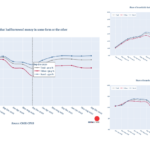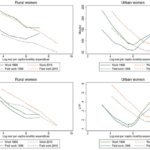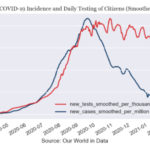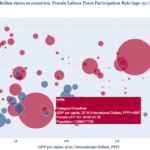AIDIS 2019: Lower assets and higher indebtedness for Indian households
Key Findings:
- Some of the richer states like Kerala, Punjab, Haryana, and Gujarat saw their overall rural average value of assets (AVA) decline in AIDIS 2019 over AIDIS 2013. Haryana, Punjab, and Kerala even saw their urban AVA decline in AIDIS 2019 over AIDIS 2013
- Cultivator households in rural India and self-employed households in urban India saw their net worth decline by 33.8 percent and 30.5 percent respectively in AIDIS 2019.
- There has been a sharp rise in average amount of debt per household (AOD) in rural India (60 percent) in AIDIS 2019 over AIDIS 2013. While AOD for cultivator households has decreased by 8 percent, that for non-cultivator households has gone up sharply (37 percent)
- Decline in non-institutional IOI for both rural and urban India.
- 84.4 percent adults in rural India and 85.2 percent adults in urban India have bank deposit accounts
The All-India Debt and Investment Survey (AIDIS) is conducted by the National Sample Survey Organisation (NSS) in both rural and urban India at periodic intervals. The latest survey was conducted between January and December 2019 and its report was released recently. According to the NSS, AIDIS 2019 sampled 5,940 villages covering 69,455 households in rural India, and 3,995 blocks covering 47,006 households in urban India. Before AIDIS 2019, the NSS had carried out the AIDIS in its 70th round (January-December 2013) which provided information on assets and liabilities of households as on 30 June 2012.
AIDIS provides us four indicators that give us a glimpse into the debt and investment situation in rural and urban India. These are:
- Average value of assets (AVA): AIDIS 2019 provides us with the average value of all physical and financial assets owned per household as on 30 June 2018.
- Incidence of Indebtedness (IOI): The latest survey tells us the percentage of households with any outstanding debt as on 30 June 2018.
- Average amount of debt (AOD): It tells us the average amount of cash dues per household as on 30 June 2018.
- Debt-asset ratio (DAR): It tells us the AOD outstanding on a given date for a group of households, as a percentage of the AVA owned by them on that date.
In this data narrative, we will look at the findings of AIDIS 2019.
Average value of assets (AVA)
The average value of all the physical and financial assets owned by a household is considered its AVA.
In rural India, households are divided into two categories based on their occupation. These are cultivator and non-cultivator. Cultivator households are households that have operated an area of land 0.002 hectare or more during the last 365 days prior to the date of the survey. All the remaining households in the village are considered non-cultivator households. According to AIDIS 2019, cultivator households constitute 57 percent of all rural households in India. In urban India, households are classified into two occupational categories — self-employed, and others. The latter includes households with regular wage or salary earnings, casual labour, and others. According to AIDIS 2019, self-employed constitute 26 percent of all households in urban India.
Figure 1 shows us AVA for cultivator and non-cultivator households in rural India as per AIDIS 2013 and 2019, and the percentage change in the period. The biggest takeaway is the 33 percent decline in the AVA for cultivator households in 2019 over 2013. At the same time, AVA for non-cultivator households has increased by 1 percent in the same period. In 2013, AVA for non-cultivator households used to be only 23 percent of cultivator households AVA. This increased to 36 percent in AIDIS 2019. All comparisons have been done using real values for AVA, using the annual WPI (2011-12 and 2017-18) to adjust 2012 values to 2018.
Figure 1
Figure 2 shows us AVA for self-employed and other households in urban India as per AIDIS 2013 and 2019 and the percentage change in the period. We find that the AVA for self-employed households in AIDIS 2019 was 29 percent lower than their AVA in AIDIS 2013 in real terms. At the same time other households saw their AVA decrease by 3 percent in real terms.
Figure 2
AVA by Social Group
In Figure 3, we can see the AVA as per AIDIS 2019 for various social groups. In rural India, SC households had an AVA of Rs 879,000 which was only 34 percent of the AVA for Others (Rs 26,03,000). Rural OBC households’ AVA was Rs 16,45,000, which was 63 percent of the AVA for Others.
This gap is wider in urban India. Other households had an AVA of Rs 40,45,000 in urban India, but this value was only Rs 13,15,000 for SC households (32 percent of Others) and Rs 21,20,000 for OBC households (52 percent of Others).
AIDIS 2013 did not provide a social group-wise break-up for households AVA.
Figure 3
AVA in States – 2013 v 2019
Figure 4 shows us the change in AVA for each state in rural and urban households between 2019 and 2013. While for India, rural households saw a 38 percent rise in their AVA in 2019 over 2013 (in real values), the story is more layered when we focus on states. We find that some of the richer states in the country like Kerala, Punjab, Haryana, and Gujarat saw the AVA for rural households decline in 2019 over 2013. In Kerala, rural households AVA declined by 21 percent in 2019 over 2013 while Punjab saw a decline of 20 percent in the same period for the rural households. Haryana, Kerala, and Punjab even saw urban households AVA decline by 31 percent, 31 percent, and 21 percent respectively. In urban India, even states like Maharashtra, and Tamil Nadu saw a decline of 15 percent. For India, overall, urban households saw their AVA increase by 3 percent in AIDIS 2019 over AIDIS 2013.
Figure 4
Figure 5 shows us how rural household AVA varies across states in India. E.g., the rural AVA for Haryana is Rs 4.48 million which is nearly 3 times the national average of Rs 1.59 million. On the other end of this spectrum are states like Odisha which has a rural household AVA of Rs 532,000 which is just 33 percent of the national average.
Figure 5
Figure 6 shows us the difference between state AVA and national AVA for urban households. We find that J&K has the highest urban AVA in the country at Rs 5.64 million which is more than double the national average of Rs 2.72 million. Even for urban households, Odisha has a low AVA of Rs 1.341 million which is nearly half the national average.
Figure 6
Indebtedness
AIDIS also provides us information on households’ indebtedness. In AIDIS 2019, a household was considered indebted if it had any cash loan outstanding on 30 June 2018. AIDIS provides us three kinds of information related to indebtedness.
- Incidence of indebtedness (IOI): IOI is the percentage of indebted households, i.e., the percentage of households that has a cash loan outstanding.
- Average amount of debt (AOD): AOD is the average amount of cash dues on 30 June 2018 per household.
- Average amount of debt per indebted household (AODL): As the term suggests, AODL is the average amount of debt per indebted household.
Figure 7 shows us the IOI in rural and urban Indian households as per AIDIS 2013 and AIDIS 2019. We find that incidence of indebtedness for both cultivator and non-cultivator households has gone down in 2019 in comparison to 2013. In urban India too, the IOI has decreased for both self-employed and other households.
Figure 7
Average Amount of Debt (AOD)
Figure 8 shows the changes in average amount of debt per household in rural and urban India with a break-up of households into cultivator and non-cultivator in rural India and self-employed and others in urban India. In rural India, we observe a sharp rise of 37 percent in AOD for non-cultivator households in AIDIS 2019 over AIDIS 2013. Overall, for rural India, AOD has increased by 60 percent in AIDIS 2019 over AIDIS 2013.
The picture is not different in urban India as self-employed households show a sharp rise (44 percent) in AOD in AIDIS 2019 over AIDIS 2013. Overall, urban Indian households AOD increased by 24 percent in AIDIS 2019 over AIDIS 2013.
AOD values from AIDIS 2013 have been adjusted for inflation.
Figure 8
Average Amount of Debt Per Indebted Household (AODL)
Figure 9 shows the changes in average debt per indebted household in urban and rural India between AIDIS 2013 and AIDIS 2019. There is a 43 percent increase in AODL for rural households in India as the average debt per indebted household increased from Rs 118,872 (adjusted for inflation) in AIDIS 2013 to Rs 170,533 in AIDIS 2019.
The rise in average debt per indebted household for urban India was 24 percent as it increased from Rs 434,595 in AIDIS 2013 to Rs 536,861 in AIDIS 2019.
Figure 9
Indebtedness across social groups
How is incidence of indebtedness spread across various social groups in Indian society? Figure 10 shows us IOI for SC, ST, OBC, and Others for both rural and urban India in AIDIS 2013 and AIDIS 2019. ST households have the lowest IOI in rural India while SC, OBC, and Other households show a similar level of IOI in rural India. ST households IOI also shows highest increase (46 percent) in AIDIS 2019 over AIDIS 2013 across all social groups.
In urban India too, ST households show the least incidence of indebtedness among all four groups reported in AIDIS 2013 and AIDIS 2019. OBC households report the highest IOI in urban India in AIDIS 2019 (25.3 percent) with SC households only slightly behind at 23.4 percent. However, when we compare the data from AIDIS 2013 and 2019, we find that urban OBC households IOI has declined by 3 percent in AIDIS 2019 over AIDIS 2013.
Figure 10
Figure 11 shows us the average amount of debt per household (AOD) for the same four social groups in AIDIS 2013 and AIDIS 2019. Here ST households show the lowest AOD in rural India while in urban India SC households have the lowest AOD. Other households show the highest AOD in both rural and urban India. There has been a sharp rise in AOD (60 percent) across rural India with the highest increase reported by ST households (114 percent) followed by other households at 76 percent. However, the rise in AOD for ST households is on a small base.
In urban India, there has been a 24 percent rise in AOD with the highest rise seen in ST households (45 percent).
Figure 11
Changes in IOI – Institutional vs Non-Institutional Credit Agencies
AIDIS divides households across India into Asset Holding Classes (or decile classes) based on asset holding size. The first decile class (or AHC 1) refers to the lowest decile class of households with the lowest asset holding (0-10 percent) and AHC 2 refers to the next 10 percent of households. AHC 10 represents the top 10 percent of households in India based on their asset holdings.
Figure 12 looks at percent changes in IOI for each of these 10 AHCs based on institutional or non-institutional credit agencies. E.g., AHC 2 in rural India saw a 93 percent rise in IOI (AIDIS 2019 vs AIDIS 2013) to institutional credit agencies while its incidence of indebtedness to non-institutional credit agencies declined by 21 percent.
We observe this pattern in nearly all AHCs as IOI to non-institutional creditors declined in AIDIS 2019 over AIDIS 2013 while IOI to institutional creditors increased. Overall (for all AHCs together), non-institutional IOI declined by 10 percent in rural India and by 23 percent in urban India.
Figure 12
AIDIS does not provide an institutional vs non-institutional credit agency-wise break up for social groups.
Financial Inclusion
AIDIS 2019 provides us the percentage of adult population having a deposit account in bank in 18 states and in India overall. We find that in rural India, 84.4 percent of adults have deposit accounts in banks. This number is 88.1 percent for rural males and 80.7 percent for rural females. In urban India, these numbers are marginally higher with 85.2 percent adults having bank deposit accounts. 89 percent urban male adults and 81.3 percent urban female adults have bank deposit accounts.
AIDIS 2019 also provides us the percentage of adults with bank deposit accounts by social groups. The numbers below show that in rural India, SC, OBC, and Others have similar percentages of adults with bank deposit accounts. In urban India however, the percentage of adults from ‘Others’ with bank deposit accounts is slightly higher.
| Rural | Urban | |
|---|---|---|
| SC | 80.4% | 80.4% |
| ST | 84.9% | 83.6% |
| OBC | 85.0% | 84.9% |
| Others | 85.1% | 86.7% |
Comparisons with AIDIS 2013
Unlike AIDIS 2019, AIDIS 2013 does not provide the percentage of adults with bank accounts across various states or across various social groups. However, AIDIS 2013 provides the proportion of households (HHs) with bank deposit accounts, post office deposit accounts or other deposit accounts. We find that 79.5 percent of all households across India had bank deposit accounts, as per AIDIS 2013. Moreover, 12.4 percent HHs had post office deposit accounts while 10.8 percent HHs had other deposit accounts.
AIDIS 2013 does not provide a social group-wise break up of HHs with deposit accounts, however.
Change in Households’ Net Worth
While AIDIS 2019 informs us of a broad decline in households’ average assets (AVA) and increase in their average debt (AOD) since AIDIS 2013, it becomes more apparent when we compare households’ net worth in AIDIS 2013 with that in AIDIS 2019. Figure 13 below shows the changes in each type of household’s net worth between AIDIS 2013 and AIDIS 2019. Net worth of a type of household has been calculated by subtracting its AOD from AVA. We find that every type of household saw its net worth decline in this period. While cultivator households’ net worth declined by 33.8 percent, non-cultivator households’ also saw their net worth decline by 0.1 percent. In urban India, self-employed households saw their net worth decline by 30.5 percent, while other households saw a decline of 3.7 percent in their net worth. All comparisons have been made using real value for AIDIS 2013.
Figure 13
Concluding Comments
Between 2013 and 2019, we note major changes in the value of assets and indebtedness indicators for rural and urban households.
- In rural India, we observe a sharp decline of 33 percent in the AVA for cultivator households in AIDIS 2019 (compared to AIDIS 2013) and a rise of 1 percent in the AVA for non-cultivator households.
- In urban India, self-employed households saw their AVA decline by 29 percent while ‘Other’ households saw a 3 percent decline in their AVA. AIDIS 2019 also highlights the large gap between various social groups when it comes to average value of assets.
- In both urban and rural India, SC households’ AVA is nearly one-third of the AVA for Other households (non-SC, ST, OBC households).
- When we look at household AVA across states, we find that richer states like Punjab, Haryana, and Kerala saw a decline in AVA for both rural and urban households in AIDIS 2019 over AIDIS 2013. Despite the decline, Haryana’s rural household AVA (Rs 44.78 lakhs) was nearly three times the national average (Rs 15.92 lakhs) and second only to Delhi’s rural AVA. Among urban households, J&K’s AVA (Rs 56.4 lakhs) was nearly twice the national average (Rs 27.17 lakhs).
- As per AIDIS 2019, there has been a 11 percent increase in incidence of indebtedness for rural (both cultivator and non-cultivator) households while the IOI for urban India has remained unchanged.
- AIDIS 2019 saw a sharp rise in average amount of debt (AOD) per household over AIDIS 2013. While AOD for rural households increased by 60 percent, the rise was 24 percent for urban households.
- There was a 43 percent rise in average amount of debt per indebted household (AODL) in rural India in AIDIS 2019 (over AIDIS 2013) and 24 percent rise in AODL for urban households.
- 84.4 percent adults in rural India and 85.2 percent in urban India have bank deposit accounts.
- When it comes to bank deposit accounts, we don’t see much difference across social groups in both urban and rural India. However, this only refers to account holdings and not to their usage.
- There has been a sharp decline in net worth of cultivator households in rural India)-33.8 percent) and self-employed households (-30.5 percent) in urban India.
The broad trend we observe in AIDIS 2019 is a decline in AVA for cultivator households in rural India and self-employed households in urban India vis-à-vis AIDIS 2013. We also see a decline in IOI for cultivator and non-cultivator households in rural India and self-employed and other households in urban India. AIDIS 2019 also reports a decline in IOI for non-institutional credit for nearly all decile classes over AIDIS 2013. The most striking finding in AIDIS 2019 is the sharp decline in households’ net worth across rural and urban India.
If you wish to republish this article or use an extract or chart, please read CEDA’s republishing guidelines.




